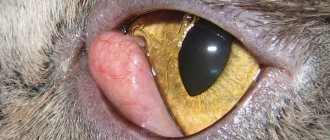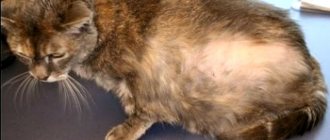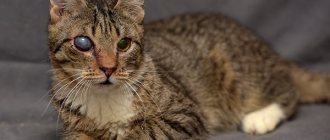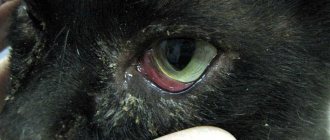As a result of circulatory disorders in the choroid of the eye, vasodilation and inflammation of the tissue structures surrounding the visual organ, hyperemia occurs.
If a cat has red eyes, the cause may be an injury to the eyeball, allergic manifestations, or infectious diseases. Redness of the tunica albuginea is always accompanied by discomfort, itching, lacrimation, pain and photophobia.
If you notice characteristic signs of eye inflammation in your pet, it is recommended to contact a veterinary clinic for help. Even if a foreign body is stuck in the animal’s eye, it is not advisable to pull it out yourself, as you can cause even more harm to the pet and aggravate the situation.
In addition, redness of the eyes can only be a sign of a serious infectious disease and without specific treatment the animal may even die.
It is important to know the main signs of diseases that cause red eyes in cats so that you can immediately consult a doctor. You also need to know how to prevent possible diseases and keep your animal safe.
Main reasons
All causes of the syndrome in the cat family can be divided into several groups:
- external causes (traumatic injuries and their consequences);
- ophthalmological causes (congenital and acquired structural changes of the eye, infectious pathologies);
- general infectious diseases;
- allergic reactions.
The diseases in each group are relatively homogeneous in origin, but differ in the nature of their course and the methods of treatment used.
Let's take a closer look at those that are most common.
External reasons
This type of hyperemia of the organ of vision occurs as a consequence of injury or exposure to various irritating substances on the cornea, namely:
- Foreign body getting into the eye. Debris or a foreign object stuck in a kitten's eye injures the delicate tissues, causing, in addition to redness, pain and lacrimation. Therefore, it is very important to remove it as soon as possible. In uncomplicated cases, the owner can cope with this on his own. But if the object has sharp edges or is located in the deep structures of the eye, then veterinary help is necessary. At the clinic, the pet will be given anesthesia, after which the foreign body will be surgically removed.
- Irritation of the cornea with soapy water when bathing or chemical agents when treating wool with insecticides. First aid consists of immediate rinsing with plenty of clean water. In the future, when carrying out various grooming procedures, it is necessary to protect the cat’s eyes from harmful influences.
- Hair hanging over the eyes of cats of long-haired breeds can prick and injure the cornea. If there is such a danger, you should always ensure that the long hairs around the eyes are neatly trimmed.
- Lens luxation. This condition can be of traumatic origin, but is sometimes a consequence of cataracts, uveitis or glaucoma. When the lens is dislocated, the iris has an abnormal appearance, and the displacement of the lens is visible to the naked eye. To reduce it, professional surgical assistance is required.
- Hyphema. With hyphema, blood accumulates in the anterior chamber. Causes may include injury or poor clotting. First of all, the cause of the hyphema is determined, then drug treatment is carried out with anti-inflammatory drugs and drugs that dilate the pupil.
- Proptosis is a partial or complete loss of the eyeball from the orbit as a result of traumatic impact. In this case, the disorder is treated surgically. If the damage is extensive, the eye may need to be removed.
Ophthalmic diseases as a cause of redness
- Blepharitis is an infectious or allergic inflammation of the eyelid. It is characterized by enlarged eyelids, discharge from the eyes, and itching. Once the cause of blepharitis is determined, medications are prescribed to eliminate it. In the case of an infectious nature of the disease, these are eye antibiotics and antifungal agents.
- Prolapse of the third eyelid gland (prolapse) is a disease in which the lacrimal gland loses its normal position, falls out of the conjunctival sac and becomes noticeable as a red formation in the corner of the eye. The prolapsed gland is removed surgically, but sometimes doctors decide to do without surgery. It is adjusted, returned to its normal position and fixed to prevent relapse.
- Conjunctivitis is inflammation of the conjunctiva. The disease may be infectious or allergic in origin. Characterized by thickened conjunctiva and lacrimation. The main method of treatment is the use of antibacterial or other drugs in accordance with the nature of the pathogen.
- Tumor of the eye and ocular structures. It can be localized in the eye or in the tissues surrounding the eye. Symptoms of the disease depend on which tissues and structures are affected. Treatment is usually surgical. If necessary, radiotherapy or chemotherapy is prescribed.
- A corneal ulcer is a violation of its surface layer. The cause of the disease may be infectious. The disease is accompanied by pain, photophobia and redness of the cornea. For treatment, local antibiotic therapy is used.
- Keratoconjunctivitis sicca most often affects older cats. Their lacrimal apparatus does not produce a sufficient amount of tear fluid, as a result of which the cornea dries out, and there is a burning sensation and irritation of the eyes in bright light. You can alleviate the animal’s condition by instilling an “artificial tear” drug to soften the cornea and replenish moisture deficiency.
- Glaucoma is the destruction of eye structures under the influence of high intraocular pressure. Accompanied by dilated pupils and clouding of the cornea. Older animals are more susceptible to pathology. In the severe stage, atrophy of the optic nerve occurs and complete blindness occurs. Symptomatic treatment is carried out by instilling drugs that reduce intraocular pressure. This allows you to slow down the destructive processes of the organ of vision.
Common infectious diseases of the body
Redness of the eyes is a symptom of some common infectious diseases. Here are some of them:
- Mycoplasmosis is a serious infectious disease, a complication of which is pneumonia. In addition to conjunctival tissue, the genitals, kidneys, and joints can be affected. If a cat has signs of a cold for a long time (cough, inflammation of the conjunctiva, nasal discharge, fever) and his eyes are red, then there is reason to assume that he has mycoplasmosis.
- Chlamydia is a chronic disease that affects the eyes, upper respiratory tract, and gastrointestinal tract. Pathogens are intracellular parasites that are resistant to any type of treatment. Red eye syndrome is caused by its conjunctival form, which can result in complete blindness.
- Calcivirosis is a viral disease, the target of which is the conjunctiva, mucous membranes of the nose and mouth, and joints. Transmitted by direct contact. The mortality rate from calcivirus among cats is very high. The main method of treatment is the prescription of local antiviral drugs and antibacterial agents (if a bacterial infection is attached).
Allergic reactions
Eye allergies to various substances (unusual food, medications, plants, household chemicals) have symptoms of allergic conjunctivitis. They are as follows: severe hyperemia of the conjunctiva and surrounding tissues, lacrimation, pain in the eyes, inability to look in bright light.
Allergic rhinitis often occurs when the animal cannot breathe through its nose, smell, and loses interest in food. Eye allergies can be expressed as allergic blepharitis (inflammation of the eyelid mucosa), allergic uveitis (inflammation of the iris). The main method of treatment is to identify the allergen, urgently remove it from the animal, and prescribe antihistamines that relieve painful symptoms.
Types of diseases
Regardless of the reasons, the following diseases develop with signs of redness of the eyes:
- blepharitis;
- conjunctivitis;
- third eyelid adenoma;
- prolapse of the nictitating membrane;
- eversion of the eyelids.
Blepharitis
The disease is often confused with conjunctivitis. However, there is a difference. Blepharitis begins with red, watery, and itchy eyes. The kitten scratches the organs of vision, inflammation of the eyelids leads to their closure. Treatment with drugs that work well for conjunctivitis does not bring relief.
Blepharospasm
Conjunctivitis
Inflammation is caused by micromycetes and bacteria that constantly live on the outer integument of the animal. The immune system prevents the rapid development of secondary microflora. But infectious diseases, external irritants, and intestinal worms weaken the defense, causing inflammation.
Chlamydia causes particular damage to the conjunctiva. These creatures, which occupy an intermediate position between bacteria and viruses, bother kittens from the age of four weeks. First one eye becomes inflamed, then the other. The disease is dangerous for humans; if handled carelessly, it can cause conjunctivitis.
Chlamydia conjunctivitis
Adenoma of the third century
This benign growth, resembling a soybean, is located near the bridge of the nose. Occurs as a consequence of injury or secondary infection. The bulge prevents the eye from closing, which leads to further injury and redness.
Adenoma of the nictitating membrane
The animal refuses food, becomes irritable and aggressive.
Prolapse of the nictitating membrane
Membrane prolapse is not an independent disease, but a symptom of the underlying one. If the disease affects one eye, then it is assumed that a speck or a congenital anomaly has gotten under the third eyelid. Bilateral inflammation is the result of infection of the organs of vision by secondary microflora during viral infections or helminthic infestations. Otherwise, the disease is called cherry eye. The angular seal of the organ of vision resembles a red berry in shape and color.
Eversion of the eyelids
Eyelashes come into contact with the eye sphere, injuring it. The disease causes pain, lacrimation, corneal hyperemia, and blepharospasm. Cats of exotic breeds are predisposed to the disease.
Glaucoma
This is an increase in intraocular pressure due to a decrease in the outflow of intraocular fluid. This pathology leads to a narrowing of the visual fields, and ultimately to complete loss of vision. Glaucoma can be primary or secondary (against the background of the underlying disease). In cats, glaucoma most often occurs after the age of 6 years and is secondary.
Symptoms:
- Redness of the eye
- Watery eyes, squinting (blepharospasm)
- Pupil dilation and signs of concomitant disease (uveitis, tumors) may be observed.
— In the case of an acute attack of glaucoma, the eye becomes cloudy, tortuous vessels on the surface of the eye are clearly visible and severe pain, the eye may increase in size.
Treatment:
1. Drugs to lower intraocular pressure.
============================================================================================================================================================================================
Red eyes in kittens
If a kitten's eye is swollen and red, one can suspect the development of various pathologies that also occur in adult animals. Often similar changes are observed in pets during early weaning from their mother.
Symptoms occur in children with weakened immune systems. They need to be provided with a balanced diet and vaccinated in a timely manner.
Diagnostics
Your veterinarian may order some tests, which include testing for the condition that causes red eye. The doctor will take your medical history and perform a physical examination to determine the underlying problem.
A complete ophthalmic examination is necessary to find the source of the eye redness. Your veterinarian may refer your pet to a veterinary ophthalmologist to evaluate your pet's condition using specialized equipment. During an eye exam, the following tests may be performed:
- Schirmer test for measuring tear quantity
- Fluorescein staining of the cornea to detect abscesses
- Tonometry to measure eye pressure
- Examination of the inside of the eye under magnification
- Scraping of inflamed tissue (eg, conjunctiva and cornea) for cytological examination for the presence of inflammation
- Eyelid scrapings to detect parasites
- Taking tissue samples to check for infections
- Biopsy of inflammation around the eyes
Therapy tactics
Treating an animal at home without conducting a comprehensive diagnosis is strictly prohibited. It is necessary to promptly seek help from a veterinarian .
When the inflammatory process develops, antibiotics and eye ointments and drops are prescribed. If symptoms arise due to the development of another pathology, the underlying disease is treated. Only after this the remaining clinical manifestations are eliminated.
Some diseases respond well to treatment, while others require the use of medications throughout the pet’s life. Sometimes cure is impossible without surgery.
The following medications will help alleviate your pet’s condition:
- Furacilin. Used for the development of conjunctivitis. The affected mucous membranes are washed.
- Levomycetin. Used for bacterial conjunctivitis. The drug is instilled into both eyes.
- Tetracycline ointment. The medication is applied to the visual organs several times during the day.
- A solution based on novocaine, hydrocortisone (injection) helps eliminate pain.
Traditional medicine
Folk remedies will help cope with the problem only in combination with medications. Chamomile decoction is often used. It is prepared in a water bath and filtered. Wash your eyes three times a day.
Also used:
- Manganese solution. Light pink liquid. It is important that all grains are completely dissolved in water, otherwise there is a risk of damage to the mucous membranes.
- A decoction of St. John's wort, calendula, sage. It is used for purulent inflammatory processes. Used as a compress. The procedure is carried out 2-3 times a day.
- Black tea. For washing mucous membranes.
First aid and prevention
Why do my cats always have red eyes? The reason is different in each specific case. The syndrome may be a consequence of violation of the rules for caring for the animal, or it may be a symptom of a serious illness. Therefore, if the redness does not go away for a long time, you should not delay a visit to the veterinarian. Only he can make a high-quality diagnosis, assess the pet’s condition and determine further treatment tactics.
If the owner does not have the opportunity to immediately go to the clinic, you can use first aid techniques for ophthalmological problems. They will help alleviate the pet’s condition somewhat and, in some cases, have a therapeutic effect.
- It is necessary to put a protective collar on the neck of a cat or kitten, which will prevent them from touching their eyes with their paws, and therefore prevent the risk of secondary infection.
- You should regularly remove discharge from the eyes and rinse them with cotton pads soaked in warm boiled water or a strong solution of tea leaves.
- To reduce the inflammatory reaction, you can instill antiseptic eye drops or an “artificial tear” drug.
- Hair hanging over the eyes should be trimmed more often so that it does not injure the cornea.
If you ignore a symptom such as redness of the eye sclera, you may miss the onset of a serious illness in your cat. It’s better to play it safe and take your pet to the veterinarian as soon as possible for an examination and consultation, so that you don’t have to regret the lost time later.
Preventive actions
Among the basic rules of prevention are the following:
- Carefully ensure that the cat does not injure its eyes when playing with other animals.
- When swimming, do not allow detergents to get into your eyes. This often leads to irritation.
- Hygienic procedures are carried out using products that do not provoke the development of an allergic reaction.
- Regularly wipe the corners of the animal's eyes with cotton swabs.
- Avoid getting hair in the eyes of long-haired animals.
Swelling and redness are the first symptoms of the onset of the inflammatory process.
If you notice that the cat begins to actively scratch the eye area, you should instill drops of artificial tears twice a day. With their help, it will be possible to eliminate irritation and dry mucous membranes.
It would be a good idea to consult a veterinarian. Pathologies at the initial stage are easier to treat.
Special protective collars will help prevent scratching of the affected area.
The best way to prevent ophthalmological pathologies is a caring and attentive attitude to the health of your pet.
The appearance of any negative changes or symptoms of inflammation is a reason to immediately contact a veterinarian.
This is the only way to preserve vision and avoid serious health problems for the animal.
Prevention
To prevent your cat from getting such an unpleasant disease as blepharitis, you must first pay attention to the hygiene of the animal’s eyes. This is especially true for breeds with a flattened muzzle - Persians and similar ones. Due to the structural features of the lacrimal canal, they have a hereditary predisposition to the development of eye diseases, including blepharitis. It is also worth paying serious attention to the conditions of keeping the cat:
- cleanliness of fur, eyes, ears;
- feed quality;
- regular preventive treatment for worms, ticks and fleas.
Why are my eyes red?
If the owner notices that his pet’s eyes have become red, the possibility of developing some disease cannot be ruled out. Why does the cat have red eyes? This is what we will find out now.
Redness can occur for the following reasons:
- structural changes in the eye and accompanying diseases;
- viral or bacterial diseases;
- allergic reactions;
- eye injuries.
Only a veterinarian can make an accurate diagnosis. There is no point in postponing a visit to him. We will tell you about the most common and dangerous diseases, signs of which are red eyes in cats.
Conjunctivitis
This is an inflammation of the protective membrane of the eye (conjunctiva). If your cat's eye is red and pus-filled, sticky and watery, he could have contracted conjunctivitis.
There are two types of disease: caused by a bacterial infection and viral. In the first case, the disease develops very quickly, in the second - quite slowly.
It is important to consider that the eyes do not always fester with conjunctivitis. The cat's eye is red. Or both eyes. A colorless mucous liquid flows out of them. And these secretions “slow down” the rapid recognition of the disease. This is a viral form of the disease.
If the pet has contracted bacterial conjunctivitis, then there may be no redness of the eyes. But purulent discharge is a prerequisite for the development of the disease.
How to treat the disease? Firstly, only a veterinarian can make an accurate diagnosis. He will prescribe antibacterial or antiviral medications that are necessary for treatment.
Preparing for going to the clinic and treatment
0 Source:
Before going to the doctor, you need to write down or note for yourself exactly when the lacrimation began, which eye began to water first, the nature of the discharge, the animal’s diet in the last few days, treatment, vaccination or surgery in the recent past, the presence of additional symptoms. This will allow the veterinarian to quickly make the correct diagnosis and prescribe effective therapy. Typically, veterinarians prescribe drugs such as furatsilin, chloramphenicol, sofradex and kanamycin, which must be used in accordance with the instructions. To speed up recovery and alleviate the animal’s condition, you can resort to auxiliary therapy, unless, of course, we are talking about a bruise or allergy, and not a serious disease of the visual organs. Eyes can be washed with furatsilin solution, infusion of calendula or chamomile, and even regular black tea. These products have an antibacterial and soothing effect. Gently wipe the eyelid area with a cotton pad soaked in the infusion, remove the crusts and drip the medicine. During manipulations, it is advisable to seek the help of someone close to you. If this is not possible, the animal must be tightly secured, for example, with a scarf. It is important to speak kindly and calmly to the cat during manipulations, so as not to scare the animal, and be sure to reward it with some kind of treat upon completion.
Symptoms and treatment of eye diseases in cats with photos
We found out what might be hiding behind a cat's red eye. Now we’ll tell you how to help your pet in the initial stages of illness.
For conjunctivitis, wash the eyes with strong brewed black tea. Or herbs such as sage, chamomile and calendula.
We invite you to familiarize yourself with: The Scottish cat breed is the embodiment of aristocracy and phlegm
Wipe the eyes several times a day (from 4 to 6). Use a new cotton swab each time. It is moistened in the solution and, without pressing too hard on the eye, it is passed from its outer corner to the animal’s nose.
Under no circumstances should tea leaves or herbal infusions be placed in the eye. Not only will this not help, but it will also make the situation worse.
A healthy cat's eyes should be clean, shiny, wide open, and the animal should not rub them frequently with its paw. Any of the following symptoms is a reason to consult a doctor immediately:
- redness, swelling, or thickening of the eyelids;
- discharge of mucous, purulent or bloody contents from the corners of the eyes;
- lacrimation;
- photophobia;
- lack of pupillary reaction to light;
- itching, causing the cat to rub its eye with its paw or rub its muzzle on objects;
- inability to fully open or close the eyelid, frequent blinking of one eye;
- foreign bodies in the eye, neoplasms on the eyelids;
- cloudy or red eyes;
- creeping onto the eye of the third eyelid;
- wounds, burns or bruises of the eyes and eyelids;
- soreness to touch.
Most often in small kittens or older individuals there are:
- Damage to the nasolacrimal ducts
photo from the site: murlyka.net.ua
Most often, at the initial stage, the animal may not experience pain, and the only thing you can do is regularly examine the pet to eliminate the risk of infectious infection and prevent suppuration and inflammation, wash its eyes and remove discharge from them.
If you notice the slightest changes, immediately take your pet to the nearest veterinary clinic - the doctor will make a diagnosis and prescribe a course of treatment with mandatory examinations as it progresses.
Turn of the century
Never try to self-treat your cat's eye problems. Many illnesses can lead to complete blindness if the wrong drugs and treatment regimens are used.
Prevention of eye diseases
Of course, no cat can be completely immune from diseases of the organs of vision, but it is within the power of a person to do everything to ensure that the risks of such diseases are as small as possible. To do this, it is necessary to provide proper care for your pet’s eyes.
To prevent bacteria from multiplying in the mucus that periodically accumulates in the corners of the cat’s eyes, this mucus must be removed. To do this, you can use special disinfectant eye lotions or herbal decoctions.
When bathing your pet, you need to make sure that the soap solution and water do not get into her eyes and do not irritate them. The same precautions should be taken when treating your furry beauty against fleas and other parasites with insecticidal drops and powders.
If the domestic predator is a long-haired breed, you need to pay attention to the length of the hair above the cat’s eyes. If the hair hangs over, then it can scratch its delicate conjunctiva unnoticed by a person, but extremely noticeably for a cat, injuring them and, as a result, causing redness.
When performing any procedures on a cat’s eyes, the owner needs to be very careful not to scratch or damage the delicate organ of vision. Do not use dry wipes or cotton wool, as their fibers may get into your eyes. It is best to moisten a napkin or cotton wool in a special eye solution intended for cleaning or in a weak chamomile decoction.
Folk remedies for treating eyes in cats
Ciprovet drops can be used to care for the eyes of cats.
To ensure that cats do not have problems with their eyes, they should be constantly looked after, and for some breeds, regular eye washing is simply necessary. To do this, use special products for animals.
Rinse drops are used as follows:
- drop 1-2 drops of the drug into each eye;
- Gently massage the cat's eyelids;
- Remove the preparation with a clean cotton pad;
- carry out the procedure twice a day.
Use lotions to remove tear tracks. They are applied to a cotton pad and gently wiped over the hair around the eyes. This procedure should be done once a day for a week. If necessary, the course is repeated.
Here are the most popular drops and lotions for cat eye care:
- Diamond Eyes (drops);
- BEAPHAR Oftal (drops);
- BEAPHAR Sensitiv (lotion);
- Bars (lotion);
- Tsiprovet et al.
In cases where going to the doctor and buying medications is not possible, you can resort to home remedies. Typically used:
- tea - brew a tablespoon of black tea with a glass of boiling water, let it cool, soak a cotton pad in the brew and wipe the sore eye with it;
- elderberry infusion - pour 10 grams of dried elderberry into 100 ml of boiling water, let it brew for 45 minutes, then strain;
- infusion of celandine - chop 5 leaves of the plant and pour two tablespoons of boiling water, let it brew for half an hour and strain;
- infusions of calendula, chamomile or St. John's wort - pour 2 tablespoons of dried leaves with a glass of boiling water, leave for 15 minutes and then strain;
- aloe leaf juice - grind 2-3 pieces in a blender and strain the juice through cheesecloth.
All means are used according to the same scheme:
- Soak a cotton pad in the liquid and gently rub it over the eye from the outer corner to the inner.
- After each pass, the disk is replaced with a new one.
- Both eyes need to be treated, even if one of them looks healthy.
The cat's eyes must be wiped from the outer corner to the inner corner to avoid the spread of infection to healthy areas.
Folk remedies are only suitable as a temporary measure to alleviate the animal’s condition; for a complete recovery, treatment prescribed by a doctor is still necessary.
Symptoms
Most cats diagnosed with hyphema have some degree of vision problems and discomfort. In cats, due to hemorrhages, visual acuity decreases and vision deteriorates.
- frequent blinking, squinting of eyes;
- tearfulness;
- inadequate reaction to pupil light;
- changes in behavior (depression, apathy, drowsiness, inactivity);
- pupil dilation;
- redness of the mucous membrane;
- swelling of the eyelids;
- decreased vision (monocular blindness if one eye is affected).
Important! Some cats experience acute pain and severe discomfort when opening or closing their eyes.
What to do at home
Keep your cat at home as quiet as possible to stop bleeding, allow the hyphema to settle in the eye, and reduce the risk of further bleeding. It may be necessary to limit your cat's physical activity for 7-10 days.
Since in some cases vision deteriorates, it is recommended not to allow the cat to go outside without supervision until complete recovery.
Do not give your cat over-the-counter human medications such as Visine or other ophthalmic medications designed to reduce eye redness or irritation, as these products are not effective for hyphema.
Contact your veterinarian as soon as possible, because some causes of hyphema are dangerous not only for the eyesight, but also for the life of the animal.
Similar articles
Recently, veterinarians have observed a sharp increase in pancreatic diseases...
Mycoplasmosis in cats is a severe infectious disease that requires the intervention of veterinarians. Even…
Leave a request for treatment for your pet right now!
Treatment
The prescribed treatment must be adequate to the form of blepharitis, the presence of symptoms, the duration of the disease, and the general condition of the animal.
If pathogenic flora of bacterial origin is detected, antibacterial drugs are prescribed to sick animals. If the nature of the infection is viral, then treatment consists of prescribing antiviral drugs.
INTERESTING TO KNOW: Asthma in cats: symptoms and treatment
In addition to therapy aimed at destroying pathogenic flora, the sick cat is prescribed medications that strengthen the immune system and vitamin complexes. Local treatment consists of using medicinal ointments, drops, and rinsing agents. The entire range of drug therapy must be prescribed by a veterinarian. Self-medication can lead to serious complications in the animal, including loss of vision.











